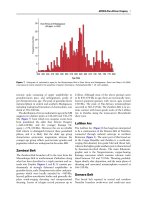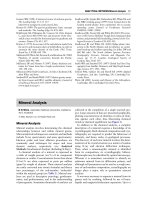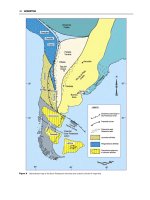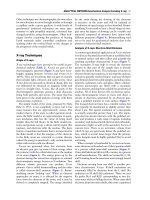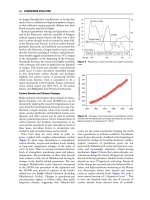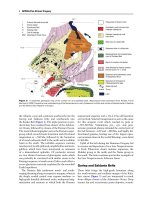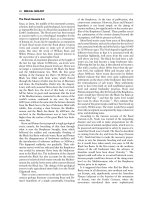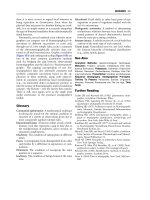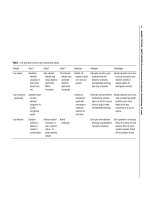Encyclopedia of geology, five volume set, volume 1 5 (encyclopedia of geology series) ( PDFDrive ) 146
Bạn đang xem bản rút gọn của tài liệu. Xem và tải ngay bản đầy đủ của tài liệu tại đây (60.46 KB, 1 trang )
ANALYTICAL METHODS/Mineral Analysis 107
Gumert WR (1998) A historical review of airborne gravity.
The Leading Edge 17: 113 117.
/>Hansen R (1999) The gravity gradiometer: basic concepts
and tradeoffs. The Leading Edge 18: 478, 480.
Hildebrand AR, Pilkington M, Connors M, Ortiz Aleman
C, and Chavez RE (1995) Size and structure of the Chic
xulub crater revealed by horizontal gravity gradients and
cenotes. Nature 376: 415 417.
Hutton C (1778) An account of the calculations made from
the survey and measures taken at Schiehallion, in order to
ascertain the mean density of the Earth. Phil. Trans.
Royal Soc. LXVIII: 689 788.
McKenzie DP, Watts AB, Parsons B, and Roufosse M (1980)
Planform of mantle convection beneath the Pacific.
Nature 288: 442 446.
McKenzie DP and Nimmo F (1997) Elastic thickness esti
mates for Venus from line of sight accelerations. Icarus
130: 198 216.
Milsom J (2002) Field Geophysics, 3rd edn. Chichester, UK:
John Wiley and Sons.
Sandwell DT and Smith WHF (1997) Marine gravity anom
aly from Geosat and ERS 1 satellite altimetry. Journal of
Geophysical Research 105: 10039 10054.
(www.ngdc.noaa.gov)
Smallwood JR, Staples RK, Richardson KR, White RS, and
the FIRE working group (1999) Crust formed above the
Iceland mantle plume: from continental rift to oceanic
spreading center. Journal of Geophysics Research
104(B10): 22885 22902.
Smallwood JR, Towns MJ, and White RS (2001) The struc
ture of the Faeroe Shetland Trough from integrated deep
seismic and potential field modelling. Journal of the Geo
logical Society of London 158: 409 412.
Smallwood JR and White RS (2002) Ridge plume inter
action in the North Atlantic and its influence on contin
ental breakup and seafloor spreading. In: Jolley DW and
Bell BR (eds.) The North Atlantic Igneous Province:
Stratigraphy, Tectonic, Volcanic and Magmatic Pro
cesses, pp. 15 37. London: Geological Society of
London, Spec. Publ. 197.
Smith WH and Sandwell DT (1997) Global Sea Floor Top
ography from Satellite Altimetry and Ship Depth Sound
ings. Science 277: 1956 1962.
Telford WM, Geldart LP, and Sheriff RE (1990) Applied
Geophysics, 2nd edn. Cambridge, UK: Cambridge Uni
versity Press.
Watts AB (2001) Isostasy and Flexure of the Lithosphere.
Cambridge, UK: Cambridge University Press.
Mineral Analysis
N G Ware, Australian National University, Canberra,
ACT, Australia
ß 2005, Elsevier Ltd. All Rights Reserved.
Mineral Analysis
Mineral analysis involves determining the chemical
relationships between and within mineral grains.
Microanalytical techniques are essential, and methods
include X-ray spectrometry and mass spectrometry.
Electron probe and laser ablation procedures are
commonly used techniques for major and trace
element analysis, respectively (see Analytical
Methods: Geochemical Analysis (Including X-Ray)).
A chemical analysis of a mineral is expressed as
a table of weight percent (wt.%) of its component
elements or oxides. Concentrations lower than about
0.5 wt.% are often expressed as parts per million
(ppm) by weight of element. These mineral analyses
are easily converted into atomic formulas and thence
into percentages of the end-member ‘molecules’
within the mineral group (see Table 1). Mineral analyses are used in descriptive petrology, geothermometry, and geobarometry, and in the understanding
of petrogenesis. Sometimes thousands of analyses are
collected in the completion of a single research project. Large amounts of data are presented graphically,
plotting concentrations of elements or ratios of elements against each other, thus illustrating chemical
trends or chemical equilibrium (see Figure 1).
In addition to the chemical analysis, a complete
description of a mineral requires a knowledge of its
crystallography. Both chemical composition and crystallography are required to predict the behaviour of
minerals, and hence rocks, in geological processes.
The discovery of each new mineral involves the determination of its crystal structure as a matter of routine
using X-ray and electron diffraction techniques.
Thus, when a monomorphic mineral is identified
from its composition, its crystallography follows.
Polymorphs may be identified by optical microscopy.
Whereas it is sometimes convenient to identify an
unknown mineral from its diffraction pattern, and
although cell parameters can be used as a rough measure of end-member composition, crystallography no
longer plays a major role in quantitative mineral
analysis.
It was once necessary to separate a mineral from its
parent rock by crushing, followed by use of heavy
liquids and magnetic/isodynamic separators. Up to a
